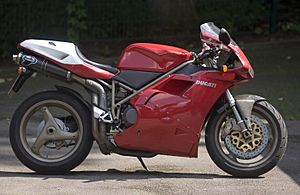Massimo Tamburini facts for kids
Quick facts for kids
Massimo Tamburini
|
|
|---|---|
| Born | November 28, 1943 Rimini, Italy
|
| Died | April 6, 2014 (aged 70) |
| Occupation | Motorcycle designer |
| Employer | Bimota, Cagiva, Ducati, MV Agusta |
|
Notable work
|
Ducati 916, MV Agusta F4 |
| Children | Morena, Andrea, Simona |
Massimo Tamburini (born November 28, 1943 – died April 6, 2014) was a very famous Italian motorcycle designer. He created amazing bikes for companies like Cagiva, Ducati, and MV Agusta. He was also one of the people who started the company Bimota.
Many people called Tamburini the "Michelangelo of motorbike design." This is because his designs were so beautiful and important. Two of his most famous bikes, the Ducati 916 and the MV Agusta F4, were even shown in a special art exhibit at the Solomon R. Guggenheim Museum!
Massimo Tamburini lived and worked in San Marino for a long time. He retired from his work at the Cagiva Research Center on December 31, 2008.
Contents
Early Life
Massimo Tamburini was born on November 28, 1943, in Rimini, Italy. His family worked as farmers. He wanted to go to university, but because of money, he went to a technical school instead.
He didn't finish his technical education due to health reasons. At 18, he started working with heating pipes.
His Passion for Motorcycles
Tamburini once said, "I have always had a huge passion for motorcycles." He called it his "obsession" even when he was a little boy! He never wanted to design anything else.
His love for motorcycles grew when he went to a big race in 1961. He was amazed by the sound of the MV Agusta engine. Even though he never went to design school, he taught himself everything. He spent his life making motorcycles.
While Tamburini owned a heating business, he became known for making motorcycles better. He would improve their power and handling. He also made them lighter. Rimini, his hometown, was a great place for motorcycle fans.
Tamburini created his first custom motorcycle design in 1971. He welded the frame himself for an MV Agusta 750 Sport.
Founding Bimota
In 1973, Tamburini, Valerio Bianchi, and Giuseppe Morri started a company called Bimota. Before this, they had been designing air conditioning ducts. The name "Bimota" comes from the first two letters of their last names: Bi (Bianchi), Mo (Morri), Ta (Tamburini).
Massimo Tamburini believed that an ideal motorcycle should be light and powerful. He said, "The ideal one would be a 750 with the power of a 1000 and the weight of a 500."
After 11 years, Tamburini left Bimota. In 1985, he joined the Cagiva Group. Cagiva had just bought Ducati that year. So, Tamburini started designing motorcycles for both Ducati and Cagiva.
His first design for Ducati was the Paso 750. This bike helped make fully covered motorcycle bodies popular.
The Famous Ducati 916
One of Tamburini's most famous designs is the Ducati 916. He worked on this classic bike at the Cagiva Research Center. Another designer, Pierre Terblanche, worked alongside him.
The Ducati 916 became known for its amazing looks. It had a special mix of sharp edges and smooth curves. This design was very new and exciting for motorcycles at the time.
After Ducati
In 1996, the Castiglioni brothers sold Ducati. Tamburini decided to stay with Cagiva. There, he designed the MV Agusta F4. This bike also received great praise.
While working on the F4 around 1996, he became sick. His son said that Massimo wanted to get better so he could finish the F4 and help MV Agusta. His last motorcycle design was the MV Agusta F3 675.
Massimo Tamburini retired from Cagiva in December 2008.
Later Years and Death
Massimo Tamburini became sick in November 2013. His health got worse, and he passed away on April 6, 2014, at 70 years old. About 500 people came to his funeral in Rimini.
Motorcycle Designs
Here are some of the motorcycles Massimo Tamburini designed:
- Bimota Tesi 1D
- Bimota KB2
- Bimota DB1
- Ducati Paso
- Ducati 916
- Ducati 748
- Ducati 996
- Ducati 998
- Cagiva Aletta Oro
- Cagiva Freccia
- Cagiva Mito
- Moto Morini Dart
- F4 750 Serie Oro
- F4 750 S
- F4 750 Senna
- F4 750
- F4 750
- F4 750 750 SPR and SR
- F4 1000
- F4 AGO
- F4 Tamburini
- F4 Senna
- F4 Veltro
- F4 750 R 312
- F4 750 CC
- MV Agusta Brutale
- Tamburini Corse T12 Massimo (This project was finished by his son Andrea Tamburini after Massimo passed away)
Awards
In 2012, Tamburini received the Sigismondo d'Oro. This is the highest award given by the city of Rimini.
See also
 In Spanish: Massimo Tamburini para niños
In Spanish: Massimo Tamburini para niños


